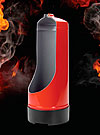New Solutions for Worldwide Securities Industries

Global market leader in thermoplastic powder coatings, Plascoat, has succeeded in improving its PPA 665 range of polymer coatings that offer almost failsafe performance for the lining of fire extinguishers worldwide. The improved Plascoat polymer coating – PPA 665 XL – recently made its debut at the International Security Industries Fair, Interschutz, in Leipzig, Germany.
Plascoat Sales and Marketing Director, Patrick Benson, says that “for some years now we have been working with the manufacturers of fire extinguishers on their need for a better internal lining of their product – especially water-filled containers made from mild steel. Much of our work has been contracted to certain OEMs in this market but a proportion has been developed as Plascoat’s own proprietary coating. PPA 665 XL has evolved in this market and represents the fruit of several years of research and development. We are delighted to be launching it at Interschutz 2010 and onto the open market worldwide.”
The Plascoat PPA 665 XL package improves on the following material properties:
- Resistance to foaming additives;
- Ease of coating;
- Improved coverage of welds;
- Long-term adhesion and protection of the metal;
- Conformity to requirements of EN3; and
- Many years experience in coating grades for rotolining extinguishers and for spraying of extinguishers.
Plascoat’s polymer coating is therefore set to appeal to those manufacturers who are challenging the position of stainless steel extinguishers in the international securities marketplace. Plascoat’s improved PPA 665 XL polymer coating offers a superior coating performance to alternative materials on mild steel particularly in its coverage of internal weld lines and edges and in its pre-emption of quality problems. Benson notes that ‘many producers are currently rethinking and recosting their production options – both for worldwide location and for production materials and methods. The mild steel based extinguisher package is therefore set to offer equivalent quality to stainless at a very competitive price.’
Benson adds that “the Interschutz exhibition only comes around every five years and provides an exceptional opportunity to talk to the securities industries about their issues and concerns. In addition to the fire market we have a number of polymer coating grades – for fences, floors and other uses – warm touch, non-slip and with other qualities that will be of interest to the market.”
In recent times it has become clear that, with an increasing demand for public environmental care and for health and safety, thermoplastic powder coatings represent the future for finishing in construction and related markets.
For full details of PPA 665XL and all other Plascoat products and services, please contact Patrick Benson or Mike Cockin at Tel. 01252 733 777, www.plascoat.com or e-mail patrick_benson@plascoat.com.
Plastic Coating Benefits
Plascoat Materials Offer:- Long-term corrosion protection to metal items;
- No VOCs, plasticizers, TGIC or halogens;
- No cracking, peeling or chipping;
- Excellent coverage of edges and welds;
- Superior resistance to salt, sea, sand and sun;
- Vandal and graffiti resistance;
- Good grip and warm feel;
- Sound and electrical insulation properties;
- Very low smoke on burning;
- Food and water contact approvals.
Applying Thermoplastic Coating Powders
Plastic coating is the process of applying a thermoplastic to the surface of metal items in order to provide long-term corrosion, impact and chemical resistance while also offering an attractive decorative finish.
Plastics tend to be applied a little thicker than standard paints and are generally impermeable to water or aggressive chemicals. As a result, thermoplastics are ideal for very long-term protection of metal in the construction and automotive industries or for the coating of welded items such as wire products, fencing, cylinders and pipes.
Plascoat’s coatings are supplied in powder (or liquid) form and are usually applied in the factory by standard fluid-bed (fluidized bed) or electrostatic spray techniques.
Thermoplastic powders can be coated in two primary methods, using either the fluidized bed dip coating process or by electrostatic spraying as summarized below.
Fluidized Bed Coating – Features and Benefits
- 100% coating efficiency;
- Faster cycle times;
- Thicker coating providing: functional protection, longer life, impact resistance but with higher material usage;
- Superior edge coverage;
- Requires fluidized bed to be full of powder.
Electrostatic Spraying – Features and Benefits
- Freely available sources of spray equipment;
- Thinner coatings;
- Lower material usage;
- Reduced inventory requirement;
- Lower coating efficiency (depending on the article and reclaim facilities).
Looking for a reprint of this article?
From high-res PDFs to custom plaques, order your copy today!






